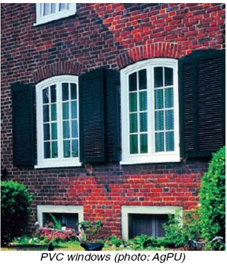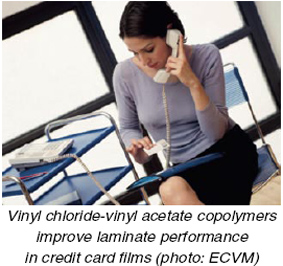
World wide demand for PVC reached 35.3 million tons in 2007 or 5.1% higher than the year before. Since 2004, it has been climbing at an average annual rate of 5.2%. This worldwide growth was driven mainly by continuing strong demandin Asia, especially in China. However, strong Chine s e demand ha s be en accompanied by the rapidly expanding construction of local PVC production sites. In 2007, China already accounted for over 30% of the world''s PVC production capacity of about 41 million tons. At a total demand of 7.8 million t of PVC in 2007 and an average annual growth rate of 4.9% from 2004 through 2007 Europe (including the CIS nations) consumes about 22% of the worldwide quantity of PVC and is thus the third largest regional market after America and Northeast Asia. The Chemical Market Associates, Inc. (CMAI), in its recently completed 2009 World Vinyls Analysis, provides historical perspective and an outlook for the global PVC, VCM and EDC markets for the period 2003 - 2013. CMAI forecasts that PVC profitability will be low in the short term with PVC demand growth slower than capacity increases in the near-term. However, to support global infrastructure development, the five year average for demand growth looks promising and CMAI''s chloralkali and vinyls consultants expect global demand to still be fairly strong, averaging about 5% annually through 2013. China continues with major coalbased PVC capacity expansions. As developing economies in Asia expand, more PVC consumption is required to meet the demands of developing infrastructures. China will remain the key country for world demand and supply issues. Their campaign to add a significant amount of PVC/VCM capacity beg an in 2004 and will continue through 2009, causing an even greater reduction in the country''s PVC imports. Having previously delivered PVC to China, major suppliers in Japan, South Korea , Taiwan and Thailand are seeking new markets for these exports. Future demand for vinyls will be mainly fueled by developing countries, like India, Indonesia and China. Infrastructure must be expanded to keep pace with their huge and growing populations, creating the need for many vinyls applications in the process. Vinyls will also play a major role in helping to support the economic development of these countries in the form of fabricated products for export. Process developments Around 90% of the world s PVC production capacity is based on the suspension method. In this discontinuous operation process, vinyl chloride, water, surfactants and organic peroxides as initiators are charge in the reactor and subsequently polymerized by stirring under pressure. The heat resulting from polymerization is dissipated via the cooled reactor wall and drawn off via reflux condensers. Technological and receptive further developments are motivated by the need to increase reactor efficiency while maintaining the product quality demanded by PVC processors. Modern polymerization equipment can now provide reactor volumes with an annual output of up to 750 t of PVC/m3. This is due in part to large volume reactor peripheries that minimize non-reaction times as well as to improved surfactants and initiator dispersions, enabling shorter charging and heating times, e. g. by hotwater charging. By using the insidecooled reactor developed by Vinnolit, heat transfer to the cooling jacket can be nearly doubled over that of conventional reactors. A method for dosing initiators, newly developed by Akzo and Vinnolit, makes it possible for the first time to control reaction speed during suspension polymerization, thus enabling optimum utilization of maximum cooling power from the very start of reaction. Last, but not least: the use of effective media to suppress power-reducing residues on interior reactor walls.

Paste PVC is manufactured a c cording to either the emulsion process (disc
Buty, koszulki, spodnie Dziecięce World wide demand for PVC reached 35.3 million tons in 2007 or 5.1% higher than the year before. Since 2004, it has been climbing at an average annual rate of 5.2%. This worldwide growth was driven mainly by continuing strong demandin Asia, especially in China. However, strong Chine s e demand ha s be en accompanied by the rapidly expanding construction of local PVC production sites. In 2007, China already accounted for over 30% of the world''s PVC production capacity of about 41 million tons. At a total demand of 7.8 million t of PVC in 2007 and an average annual growth rate of 4.9% from 2004 through 2007 Europe (including the CIS nations) consumes about 22% of the worldwide quantity of PVC and is thus the third largest regional market after America and Northeast Asia. The Chemical Market Associates, Inc. (CMAI), in its recently completed 2009 World Vinyls Analysis, provides historical perspective and an outlook for the global PVC, VCM and EDC markets for the period 2003 - 2013. CMAI forecasts that PVC profitability will be low in the short term with PVC demand growth slower than capacity increases in the near-term. However, to support global infrastructure development, the five year average for demand growth looks promising and CMAI''s chloralkali and vinyls consultants expect global demand to still be fairly strong, averaging about 5% annually through 2013. China continues with major coalbased PVC capacity expansions. As developing economies in Asia expand, more PVC consumption is required to meet the demands of developing infrastructures. China will remain the key country for world demand and supply issues. Their campaign to add a significant amount of PVC/VCM capacity beg an in 2004 and will continue through 2009, causing an even greater reduction in the country''s PVC imports. Having previously delivered PVC to China, major suppliers in Japan, South Korea , Taiwan and Thailand are seeking new markets for these exports. Future demand for vinyls will be mainly fueled by developing countries, like India, Indonesia and China. Infrastructure must be expanded to keep pace with their huge and growing populations, creating the need for many vinyls applications in the process. Vinyls will also play a major role in helping to support the economic development of these countries in the form of fabricated products for export. Process developments Around 90% of the world s PVC production capacity is based on the suspension method. In this discontinuous operation process, vinyl chloride, water, surfactants and organic peroxides as initiators are charge in the reactor and subsequently polymerized by stirring under pressure. The heat resulting from polymerization is dissipated via the cooled reactor wall and drawn off via reflux condensers. Technological and receptive further developments are motivated by the need to increase reactor efficiency while maintaining the product quality demanded by PVC processors. Modern polymerization equipment can now provide reactor volumes with an annual output of up to 750 t of PVC/m3. This is due in part to large volume reactor peripheries that minimize non-reaction times as well as to improved surfactants and initiator dispersions, enabling shorter charging and heating times, e. g. by hotwater charging. By using the insidecooled reactor developed by Vinnolit, heat transfer to the cooling jacket can be nearly doubled over that of conventional reactors. A method for dosing initiators, newly developed by Akzo and Vinnolit, makes it possible for the first time to control reaction speed during suspension polymerization, thus enabling optimum utilization of maximum cooling power from the very start of reaction. Last, but not least: the use of effective media to suppress power-reducing residues on interior reactor walls.
World wide demand for PVC reached 35.3 million tons in 2007 or 5.1% higher than the year before. Since 2004, it has been climbing at an average annual rate of 5.2%. This worldwide growth was driven mainly by continuing strong demandin Asia, especially in China. However, strong Chine s e demand ha s be en accompanied by the rapidly expanding construction of local PVC production sites. In 2007, China already accounted for over 30% of the world''s PVC production capacity of about 41 million tons. At a total demand of 7.8 million t of PVC in 2007 and an average annual growth rate of 4.9% from 2004 through 2007 Europe (including the CIS nations) consumes about 22% of the worldwide quantity of PVC and is thus the third largest regional market after America and Northeast Asia. The Chemical Market Associates, Inc. (CMAI), in its recently completed 2009 World Vinyls Analysis, provides historical perspective and an outlook for the global PVC, VCM and EDC markets for the period 2003 - 2013. CMAI forecasts that PVC profitability will be low in the short term with PVC demand growth slower than capacity increases in the near-term. However, to support global infrastructure development, the five year average for demand growth looks promising and CMAI''s chloralkali and vinyls consultants expect global demand to still be fairly strong, averaging about 5% annually through 2013. China continues with major coalbased PVC capacity expansions. As developing economies in Asia expand, more PVC consumption is required to meet the demands of developing infrastructures. China will remain the key country for world demand and supply issues. Their campaign to add a significant amount of PVC/VCM capacity beg an in 2004 and will continue through 2009, causing an even greater reduction in the country''s PVC imports. Having previously delivered PVC to China, major suppliers in Japan, South Korea , Taiwan and Thailand are seeking new markets for these exports. Future demand for vinyls will be mainly fueled by developing countries, like India, Indonesia and China. Infrastructure must be expanded to keep pace with their huge and growing populations, creating the need for many vinyls applications in the process. Vinyls will also play a major role in helping to support the economic development of these countries in the form of fabricated products for export. Process developments Around 90% of the world s PVC production capacity is based on the suspension method. In this discontinuous operation process, vinyl chloride, water, surfactants and organic peroxides as initiators are charge in the reactor and subsequently polymerized by stirring under pressure. The heat resulting from polymerization is dissipated via the cooled reactor wall and drawn off via reflux condensers. Technological and receptive further developments are motivated by the need to increase reactor efficiency while maintaining the product quality demanded by PVC processors. Modern polymerization equipment can now provide reactor volumes with an annual output of up to 750 t of PVC/m3. This is due in part to large volume reactor peripheries that minimize non-reaction times as well as to improved surfactants and initiator dispersions, enabling shorter charging and heating times, e. g. by hotwater charging. By using the insidecooled reactor developed by Vinnolit, heat transfer to the cooling jacket can be nearly doubled over that of conventional reactors. A method for dosing initiators, newly developed by Akzo and Vinnolit, makes it possible for the first time to control reaction speed during suspension polymerization, thus enabling optimum utilization of maximum cooling power from the very start of reaction. Last, but not least: the use of effective media to suppress power-reducing residues on interior reactor walls.  Paste PVC is manufactured a c cording to either the emulsion process (discButy, koszulki, spodnie Dziecięce
Paste PVC is manufactured a c cording to either the emulsion process (discButy, koszulki, spodnie Dziecięce













